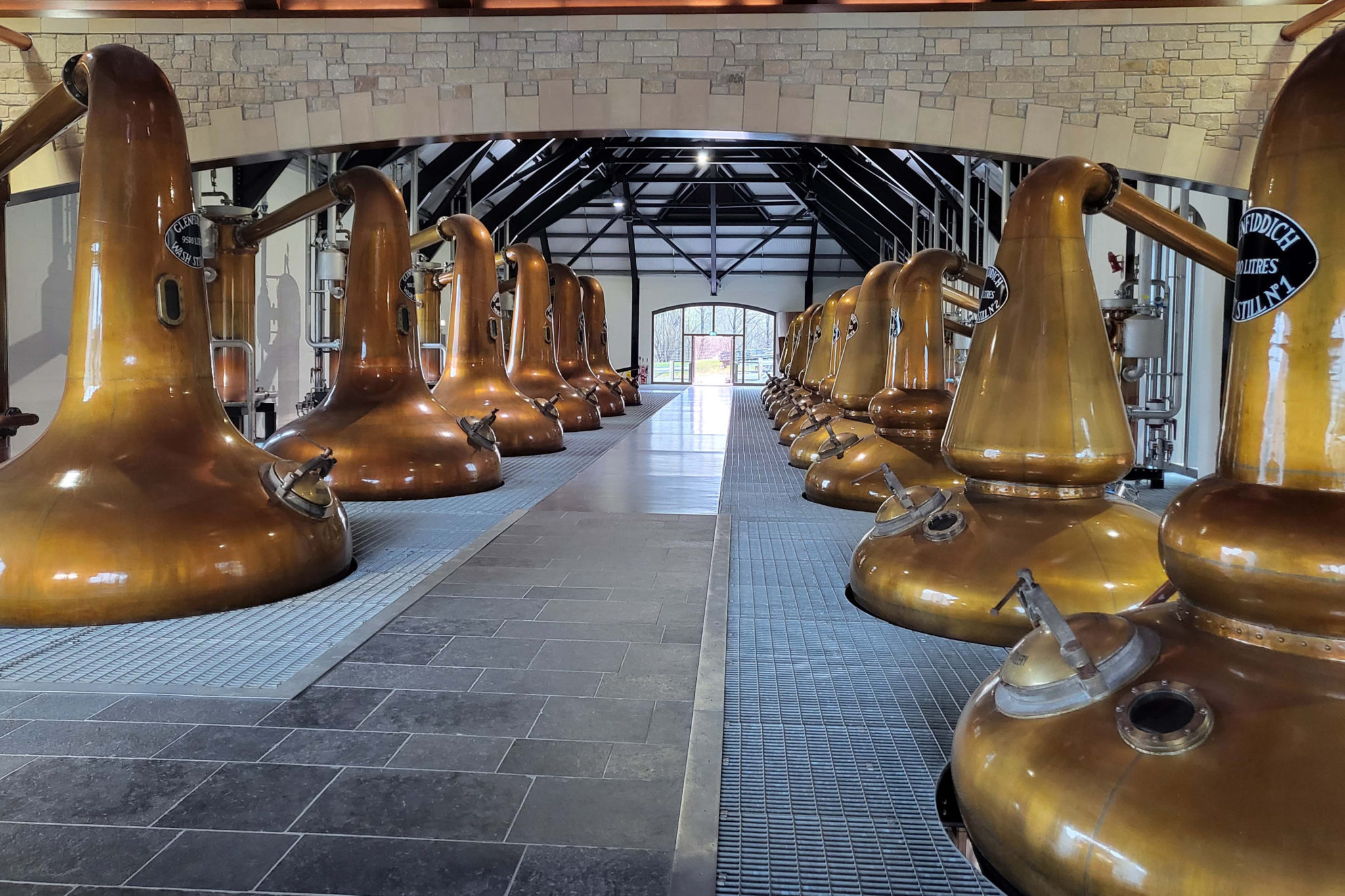Sponsored article: A day in the life at Glenfiddich

THE day starts early at one of Scotland’s best-known whisky distilleries.
Glenfiddich, located just outside Dufftown in Speyside and next door to its two siblings, Kininvie and The Balvenie, has been producing whisky since 1887.
While the world has changed a lot since then, you’d be surprised how much of the process is essentially the same.
Visiting the distillery last month, SLTN was struck by the scale of the operation there – as well as the attention to detail that goes into creating quality spirit in such vast quantities.
Many distilleries use one mash tun. Some bigger operators will have two. Glenfiddich uses four.
In fact, saying the day starts early is even a bit of a misnomer. The day at Glenfiddich doesn’t really start or finish at all. Production at the site only rarely stops, with the facility’s equipment working twenty four hours a day to create the 21 million litres of liquid the site will produce each year.
Every night the distillery receives around 150 tonnes of malted barley to use in its production, with the barley milled, mixed with water and then loaded in batches into Glenfiddich’s four mash tuns. These huge vessels will take around ten tonnes of malt each, with the mashing process taking around six hours and each tun producing around 40,000 litres of wort – the sugary liquid that is now ready for fermentation.
Sustainability has become a priority across the whisky industry in recent years and it’s something Glenfiddich takes seriously. The distillery has had heat exchangers in place for years and these, along with an anaerobic digestion system, ensure all waste – whether it’s heat or the leftover ‘draff’ (the spent malted barley) from the mashing process – is converted into energy and used to power the facility.
It’s already an impressive process at this stage but, again, the scale of it is what really sets it apart.
Many whisky distilleries will use a single mash tun in their production. Some of the really big operations might use two. Glenfiddich uses four. And they’re working all the time. All day. Every day.
With the mashing complete, the wort is transferred to washbacks for fermentation.
These giant, 50-foot wooden structures, hand-made from Douglas Fir, will host the liquid for the next 72 hours as it is slowly transformed by the fermentation process.
Despite being right next door to the mash room, the washback rooms are a world apart. Where the mashing process is about heat and noise, the fermentation is a much cooler, quieter affair.
On the surface, at least.
Inside the giant vessels quite a bit is happening. Yeast is added to the liquid, kickstarting the fermentation process and transforming the sugars in the wort into alcohol.
Struan Grant Ralph, global brand ambassador for Glenfiddich, said that opting for these handmade wooden washbacks isn’t necessarily the easiest option for the distillery, but it pays off in the long run.
“These are quite a lot of work to build,” he told SLTN.
“But once they’re in, you can actually maintain a better temperature with them. And we found that the new make quality we were getting from wooden washbacks was better than it was from stainless steel.”
The 48 washbacks at the distillery were constructed by a family-owned business in nearby Dufftown, which has been constructing washbacks for three generations. It’s another example of the size and scale of Glenfiddich’s production – 48 is a dizzying number of washbacks – married to handmade, artisanal practices.
By the end of the 72 hours the wort has become a beer-like alcoholic liquid called ‘wash’ and it’s time for the most high-profile part of the process: distillation.
Glenfiddich recently upgraded its already impressive distillation equipment with the addition of a new stillhouse.
It was the addition of this stunning, state-of-the-art new facility which allowed the distillery to increase its production from 13 million to 21 million litres a year.
Glenfiddich now operates 43 copper stills across two stillhouses.
The wash will pass firstly through one of the distillery’s wash stills, emerging as ‘low wines’, before being distilled again in spirit stills.
Unusually, Glenfiddich uses two differently shaped spirit stills – a callback to the distillery’s early days under founder William Grant.
Lauren Wood, who heads the distillery’s team of tour guides, explained: “When William Grant first started his distilling equipment came second-hand from Cardhu Distillery.
“So we’ve got similar shapes and sizes to what we first started with.”
Emerging from the spirit stills as new make spirit, the liquid is then transferred to oak casks for the longest part of the production process, maturation.
Again, the contrast between the heat and hum of the stillhouses and the cool quiet of the warehouses is stark.
Here, Glenfiddich’s quality spirit will spend time resting in a variety of American and European oak casks for years and even decades before being decanted into marrying tuns – large vats constructed from Portuguese wood – to give spirit from different casks a chance to marry together for a time before bottling.
In another unusual and innovative twist to the production process, Glenfiddich uses a Spanish sherry-inspired ‘Solera’ system in the maturation of some of its whisky.
This specially-constructed, 38,000 litre vat is never entirely emptied, but instead is topped up with new casks when its contents fall to the halfway point. This way each fresh cask that is added is able to spend time marrying with older spirit.
The addition of a stunning new stillhouse increased capacity to 21 million litres a year.
Glenfiddich’s 15 year old whisky spends time in the Solera, as well as several expressions bottled for the travel retail market.
SLTN is able to see the system in action first-hand, with warehousemen busy emptying casks into the Solera during our tour.
“Whisky making here was grounded in blends,” said Struan.
“Grant’s is what put us on the whisky map. And one thing about blending is that you need to bring everything together to create flavour and consistency. So we’re almost taking that principle into single malts with the Solera process and the tun marrying.”
With maturation complete, the finished single malt is now ready for bottling, marking the end of a process that in some cases has taken decades.
Meanwhile, with another grain delivery, it’s all starting again.



















